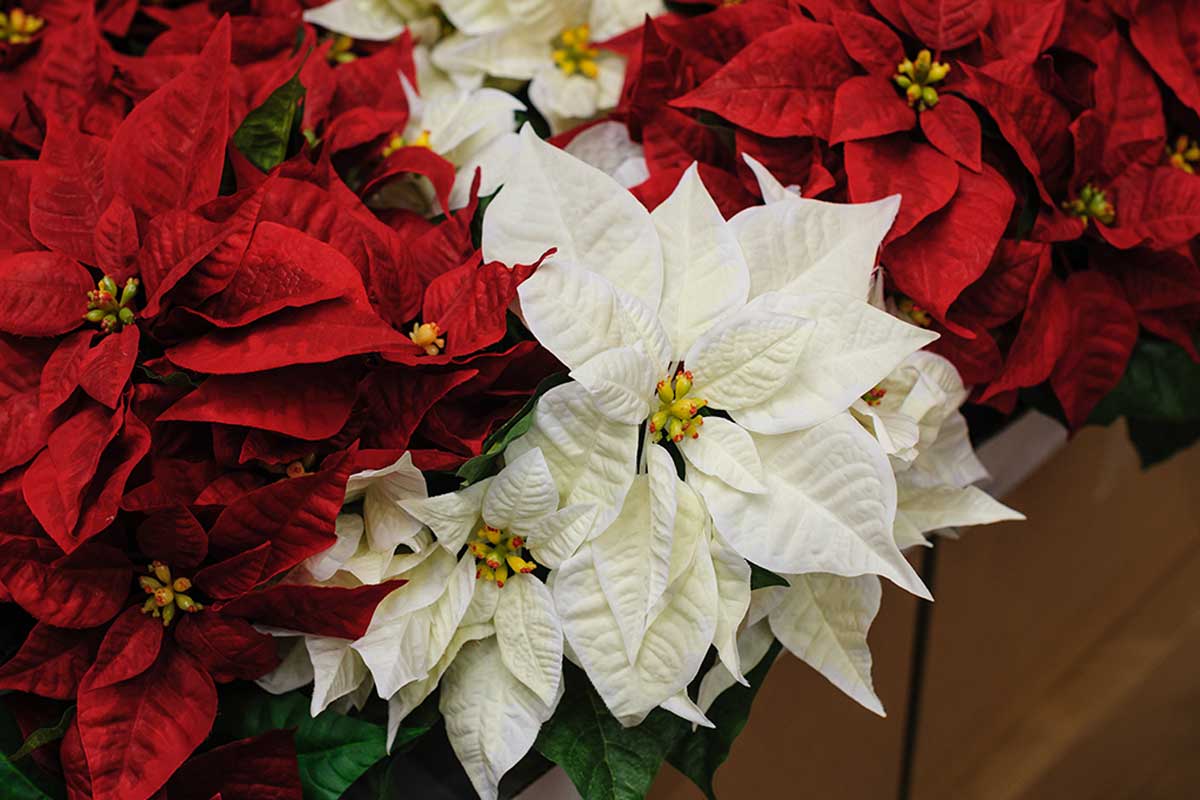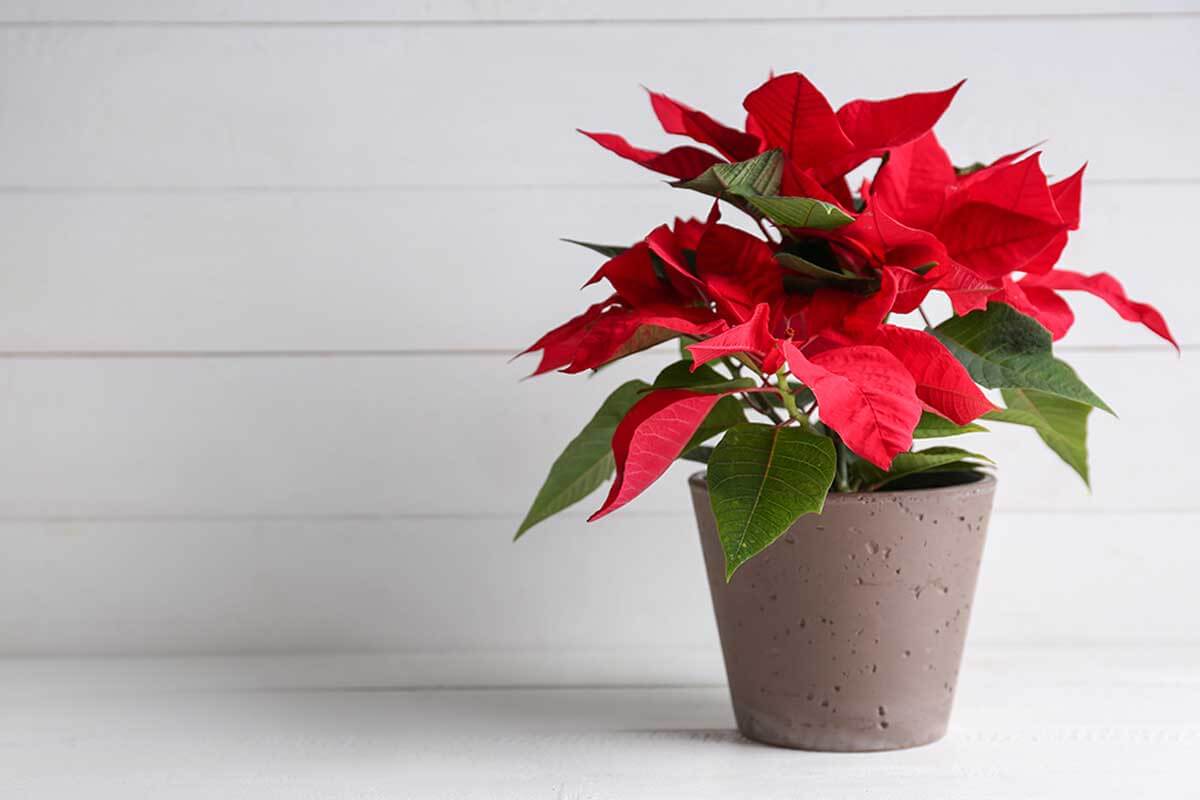Poinsettia: Everything You Need to Know

The poinsettia is typically associated with Christmas for its beautiful red and green colors. It comes from Mexico and other Latin American countries with hot climates, although it adapts very well to low temperatures.
Although it can bloom at any time of the year, it’s in December when the flowering is most abundant, which is why it’s used for a wide variety of Christmas decorations. The poinsettia is characterized by having vivid green leaves that end in a point, which combine with the intense red-colored flowers. There are also varieties of pink, yellow, and white flowers.
Tips for growing a beautiful poinsettia

When you buy a poinsettia from the store you need to take into account several aspects. Among those, make sure that the flowers don’t have any stains, variations in color, or signs of deterioration. For its part, the stem shouldn’t have any cracks or breaks either.
You also have to consider all the needs that this plant has. So also buy a pot according to the size of your plant, and use a good substrate and fertilizer. To make the best purchase, keep reading because we’re going to delve into everything you’ll need to ensure your poinsettia flourishes.
Substrate and water for your Christmas flower
The poinsettia needs a dry substrate to grow properly, which means you must prevent it from becoming waterlogged and you’ll need to avoid excess watering. During the summer, your plant will only need watering twice a week to keep the soil moist.
After flowering, the frequency of watering can be decreased to once a week. It’s important that when you do water it, you don’t wet the leaves or the flowers. Water the substrate directly and choose a pot that allows for drainage.
Poinsettia compost
The poinsettia requires your love and care in order to thrive. This includes using compost with a variety of nutrients, minerals and vitamins. Ask the seller for compost recommendations and remember that organic ones are preferred as they positively impact the environment.
The seller will probably recommend using a liquid fertilizer, as it’s very effective. By applying this every 15 days, you’ll contribute to its rapid growth. Of course, keep in mind that it’s not recommended to apply flower fertilizers when the petals have begun to take their final color.
Possible pests and diseases
If you want to decorate your home at Christmas with poinsettia, you’ll want to ensure that it stays healthy. Therefore, be alert to any potential disease or pest. Some of the most common pests on this plant are spider mites, mealybugs, aphids and whiteflies, which usually appear during flowering.
However, these pests and diseases have a solution. Simply apply an organic or homemade pesticide or insecticide. You can also ask in the store about the most recommended product for this plant.
How to care for your poinsettia at home

The poinsettia isn’t a complicated plant to care for. With some basic actions on your part, it’ll remain radiant. Among these aspects, priority must be given to light exposure, temperature, and pruning. Read on to find out how easy it is to take care of it.
The ideal light exposure for the poinsettia
The poinsettia needs a lot of direct light. It’s appropriate to leave it in direct sunlight for eight or nine hours a day. The rest of the time, you should place it in a shady spot where there’s no direct sunlight. This combination of light favors the growth, budding and flowering of the leaves.
The ideal temperature
Considering that the Christmas flower comes from areas with a warm climate, the ideal temperature is between 60 and 68 degrees Fahrenheit. Although it can withstand low temperatures, frost can be quite damaging. On the other hand, high temperatures can wilt and damage the leaves.
Pruning
The best time to prune the poinsettia is at the end of January. By that date the plant will have lost most of its leaves and flowers. The first thing you should do is prune the stems at the height of the third bud or about ten centimeters.
Follow with the smaller branches and seal the cut with a special healing paste or melted wax. Take the opportunity to check the roots and if they’re abundant, transplant your poinsettia to a larger pot, add fertilizer and give it light
Consequences of poor care
If you don’t take basic care of your Christmas plant, you’ll have dry, wilted, yellow and lifeless leaves.
Considering that the leaves speak with their color, so if yours turn black it means that they’re rotting and excess watering may be the reason. If they turn yellow, you can suspect prolonged exposure to direct sunlight or heat.
The poinsettia and pets
The poinsettia is beautiful and enhances all Christmas decor. However, if you have pets, you should be very careful. This plant contains a highly toxic sap (due to its latex content) which emerges when an animal bites the leaves and stems.
Experts have found that this causes symptoms such as abdominal pain, vomiting and severe diarrhea in dogs and cats. So it’s better to place your poinsettia somewhere out of reach.
The poinsettia is typically associated with Christmas for its beautiful red and green colors. It comes from Mexico and other Latin American countries with hot climates, although it adapts very well to low temperatures.
Although it can bloom at any time of the year, it’s in December when the flowering is most abundant, which is why it’s used for a wide variety of Christmas decorations. The poinsettia is characterized by having vivid green leaves that end in a point, which combine with the intense red-colored flowers. There are also varieties of pink, yellow, and white flowers.
Tips for growing a beautiful poinsettia

When you buy a poinsettia from the store you need to take into account several aspects. Among those, make sure that the flowers don’t have any stains, variations in color, or signs of deterioration. For its part, the stem shouldn’t have any cracks or breaks either.
You also have to consider all the needs that this plant has. So also buy a pot according to the size of your plant, and use a good substrate and fertilizer. To make the best purchase, keep reading because we’re going to delve into everything you’ll need to ensure your poinsettia flourishes.
Substrate and water for your Christmas flower
The poinsettia needs a dry substrate to grow properly, which means you must prevent it from becoming waterlogged and you’ll need to avoid excess watering. During the summer, your plant will only need watering twice a week to keep the soil moist.
After flowering, the frequency of watering can be decreased to once a week. It’s important that when you do water it, you don’t wet the leaves or the flowers. Water the substrate directly and choose a pot that allows for drainage.
Poinsettia compost
The poinsettia requires your love and care in order to thrive. This includes using compost with a variety of nutrients, minerals and vitamins. Ask the seller for compost recommendations and remember that organic ones are preferred as they positively impact the environment.
The seller will probably recommend using a liquid fertilizer, as it’s very effective. By applying this every 15 days, you’ll contribute to its rapid growth. Of course, keep in mind that it’s not recommended to apply flower fertilizers when the petals have begun to take their final color.
Possible pests and diseases
If you want to decorate your home at Christmas with poinsettia, you’ll want to ensure that it stays healthy. Therefore, be alert to any potential disease or pest. Some of the most common pests on this plant are spider mites, mealybugs, aphids and whiteflies, which usually appear during flowering.
However, these pests and diseases have a solution. Simply apply an organic or homemade pesticide or insecticide. You can also ask in the store about the most recommended product for this plant.
How to care for your poinsettia at home

The poinsettia isn’t a complicated plant to care for. With some basic actions on your part, it’ll remain radiant. Among these aspects, priority must be given to light exposure, temperature, and pruning. Read on to find out how easy it is to take care of it.
The ideal light exposure for the poinsettia
The poinsettia needs a lot of direct light. It’s appropriate to leave it in direct sunlight for eight or nine hours a day. The rest of the time, you should place it in a shady spot where there’s no direct sunlight. This combination of light favors the growth, budding and flowering of the leaves.
The ideal temperature
Considering that the Christmas flower comes from areas with a warm climate, the ideal temperature is between 60 and 68 degrees Fahrenheit. Although it can withstand low temperatures, frost can be quite damaging. On the other hand, high temperatures can wilt and damage the leaves.
Pruning
The best time to prune the poinsettia is at the end of January. By that date the plant will have lost most of its leaves and flowers. The first thing you should do is prune the stems at the height of the third bud or about ten centimeters.
Follow with the smaller branches and seal the cut with a special healing paste or melted wax. Take the opportunity to check the roots and if they’re abundant, transplant your poinsettia to a larger pot, add fertilizer and give it light
Consequences of poor care
If you don’t take basic care of your Christmas plant, you’ll have dry, wilted, yellow and lifeless leaves.
Considering that the leaves speak with their color, so if yours turn black it means that they’re rotting and excess watering may be the reason. If they turn yellow, you can suspect prolonged exposure to direct sunlight or heat.
The poinsettia and pets
The poinsettia is beautiful and enhances all Christmas decor. However, if you have pets, you should be very careful. This plant contains a highly toxic sap (due to its latex content) which emerges when an animal bites the leaves and stems.
Experts have found that this causes symptoms such as abdominal pain, vomiting and severe diarrhea in dogs and cats. So it’s better to place your poinsettia somewhere out of reach.
All cited sources were thoroughly reviewed by our team to ensure their quality, reliability, currency, and validity. The bibliography of this article was considered reliable and of academic or scientific accuracy.
- Nogué Xarau, S., Sanz-Gallén, P., & Blanché Vergés, C. (2000). Intoxicaciones por plantas. Medicina integral, 36(10), 371–379. https://www.elsevier.es/es-revista-medicina-integral-63-articulo-intoxicaciones-por-plantas-i–10022181







